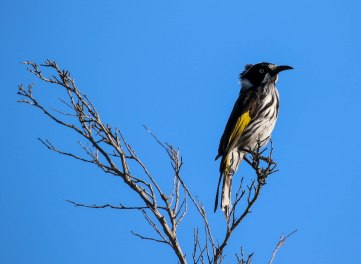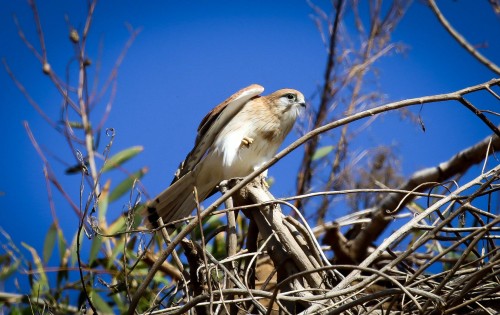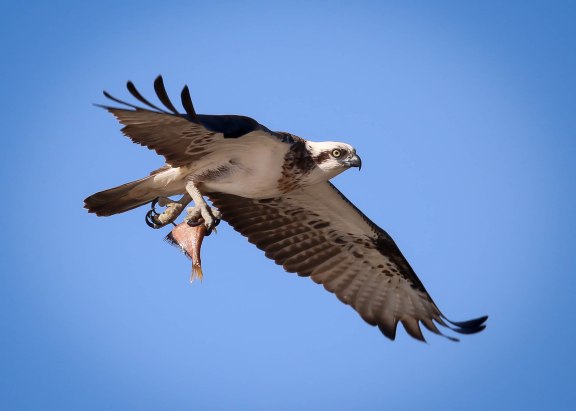Target Species: Peregrine Falcon
 As I left early, I was confronted by a frigid Sunday morning, brimming with lustrous sunshine and cool, crisp air, eager to hunt down and photograph a Peregrine Falcon or two. I was off to North Head in Sydney Harbour, to find this ubiquitous species, venturing to a spot where I had seen them nesting in previous years. It had been a few years since I had glimpsed these birds in this particular spot and I was hoping the birds would be waiting for me (in excellent photographic view of course). The gleaming, golden sunshine would irradiate them perfectly. I hastily jumped out of the car and ardently strode toward the spot. Problem was…
As I left early, I was confronted by a frigid Sunday morning, brimming with lustrous sunshine and cool, crisp air, eager to hunt down and photograph a Peregrine Falcon or two. I was off to North Head in Sydney Harbour, to find this ubiquitous species, venturing to a spot where I had seen them nesting in previous years. It had been a few years since I had glimpsed these birds in this particular spot and I was hoping the birds would be waiting for me (in excellent photographic view of course). The gleaming, golden sunshine would irradiate them perfectly. I hastily jumped out of the car and ardently strode toward the spot. Problem was…
I was in the wrong spot.
After a few years between visits, I had mixed up locations. I had mistaken my Heads. I was meant to be at Middle Head.
Not to worry, I had a walk around anyway, the only notable species photographed being a Silvereye and a New Holland Honeyeater, the latter inhabiting North Head in abundance. Next time for the Peregrines.

The next place on the list was Long Reef Aquatic Reserve on the Northern Beaches of Sydney, approximately 20km from Sydney CBD. It covers approximately 70 hectares, ranging from the rocky shore out about 100m to sea. The protection of this rocky shore habitat was established to maintain the marine invertebrates and sub-tidal marine plants and animals. The surf exposed ledges and sheltered boulders make it a perfect habitat for shellfish, crabs, seaweed and sea squirts, but most importantly, (to me and hopefully anyone reading this) non-migratory and migratory birds. Short-Tailed Shearwater or Muttonbird are seen feeding offshore in the Summer months, Black Browed Albatross are seen flying north to spend their Winter in the Arctic, a pair of Nankeen Kestrels expectedly await their new arrivals every season, Red Necked Stint are found, foraging in the Summer, Pied Oystercatcher feed on crustaceans, marine worms and small fish in the shallows and Superb Fairy-Wren gregariously gather on the grassy headland. The Long Reef Aquatic Reserve supports a multitude of bird species, of an array of behavioural type; an ideal place for a bird photographer.

My goal was to photograph waders and hopefully, some Nankeen Kestrels. I had checked the tide times and low tide was due about an hour after I arrived, so I was hopeful of spotting some whimsical waders. The impeccable weather had brought along the families along the beach and into the inter-tidal pools. Fearful of some erratic child chasing the birds away, I promptly spotted some White-Faced Heron and was reticent in my approach. My favourite part of wildlife watching/photography is watching animals do animal things and I aim to photograph accordingly. My favourite/most sought after shots are wildlife feeding, nesting, courting, most behavioural traits (maybe not mating, if I said my goal was to find wildlife mating and aim to capture that in a still-frame shot, that would be just weird). At the tidal pools, I was handed the good fortune of watching the heron feed. I was fascinated in the unwavering, unyielding positions of the heron, searching, looking and finding. After churning up the water with its feet and with much of a sudden, expeditious strike, they nabbed their intended prey, full-force with its formidable beak, standing resolute, then repeating the process, onto its next, unfortunate target.



I moved further down the rocky, tidal pools to find a pair of Sooty Oystercatcher standing obstinately in the flowing tidal waves. Always an awesome sight.

After some snaps, I continued up the beach to find the first of the 6 Nankeen Kestrels for the day. This guy (or gal) had found the perfect perch, gazing out over the beach, just out of view of the chattering people, staring from the lookout, mouths agape, posing for their Instagram stories. I found another kestrel perched on a slender limb of a Coastal Banksia (Banksia integrifolia). Excellent viewing. I was perfectly satisfied with my Sunday morning, like a thirsty Englishman to a pint, when suddenly, my two nankeen kestrels, as well as 4 others descended upon another Banksia tree. As I followed the agitated kestrels I noticed a larger, more robust bird perched amongst the Banksia that was being unceremoniously bombarded by kestrels. It had to be an Eastern Osprey or a White-Bellied Sea-Eagle, both local birds, both cashed-up and lucky enough to afford residency on the Northern Beaches of Sydney.

I raced northward up the beach, in a run-jog-walk, trying not to give off weird-guy vibes. Lucky for me the bird flew south, right at me, and I was fortunate to get some flight pictures as it flew just over the breakers. It was an Eastern Osprey, a bird I had only seen once or twice before. I followed it down the beach, like a little boy chases a balloon, except I am a grown man and I was chasing a bird. Upon first glance, I saw the Osprey definitely holding some prey. Now unless this Osprey was a vegan, it was definitely holding some fish, not a radish. I was determined. This is an animal doing an animal thing! I needed to follow.

The osprey was circling the outer rocks of the headland and landed, presumably to eat its fish (or radish, I wasn’t 100% sure yet). I was perfectly satisfied watching when it took off and returned back into its beautiful flight. At this time, I looked around and I realised I was standing amongst a bunch of parents and their small children building structures with rocks and castles with sand (known as sand castles). And there I was standing there, chasing a bird with a zoom lens in hand. Needless to say, as I watched the parents pull their children closer, I was a little uncomfortable being that weird guy in a beanie, camera and zoom lens in tow. I didn’t mind as much, for I thought their kids had built really bad sand castles. I secretly wanted to kick them over. But I divulge. The Osprey decided to fly directly overhead, directly at me! Right at me in my viewfinder! I was very, very fortunate to snap some inflight pictures and confirm that the osprey was holding a fish, not a radish (maybe it was a pescatarian). I watched it fly south to some further rocks, away from people and their poorly skilled children.




What a treat. Best photos to date for me! I was oh so lucky! My day started with visiting the wrong Headland and missing my intended species, and ended with an unexpected visitor; an animal doing animal things! Another alluring wildlife experience. I am slowly, getting hooked!

You had a great outing…watching an Osprey dive and get a fish, then wiggle it around to the proper position and fly off to a perch to eat it is really a privilege. It’s interesting that we have similar birds here – we have an Oystercatcher, herons of course – one very similar to yours – and an osprey. No Honeyeaters though! Thanks for the follow – I appreciate it!
LikeLike
Thanks very much, it is very much appreciated! Watching the Osprey was a real highlight and as I said, really boosts the motivation for similar experiences. Wish we had hummingbirds over here!
LikeLike